From above, motorboats, full of tourists, can be seen sailing towards Lembongan Island that is right next to Ceningan Island.
The two islands are located in the Nusa Penida Archipelago cluster that is famous for the beauty of its coastal destinations and attracts tourists to enjoy the unique nature tourism, with strong local culture.
Director of Maritime Affairs and Fisheries of the National Planning and Development Agency (Bappenas) Sri Yanti stated that clusters of coral reefs across Indonesia, including in the Bali waters, need to be maintained to continue providing economic and ecological benefits for tourism, food, health, and the environment.
"In 2045, when Indonesia will turn 100 years old, Indonesia will own 30 percent of the marine conservation areas. The target is contained in the government's long-term development plan," she noted in Lembongan Island, Bali, at the end of June.
Since 1998, the Indonesian government has initiated the protection and preservation of marine ecosystems through the Coral Reef Rehabilitation and Management Program (Coremap) funded by loans and grants.
The program, running for 25 years, will officially end in August 2023. A budget of around US$200 million was recorded to have been spent. Coremap aims to protect, rehabilitate, and manage the sustainable use of coral reefs and marine ecosystems in the country.
The long journey of the program has provided valuable experience for Indonesia in managing marine ecosystems independently to cut foreign assistance.
Various coral reef management practices carried out by related stakeholders have supported the welfare of coastal communities and encouraged the active involvement of local governments to jointly manage and preserve marine ecosystems.
Platform Optimization
The United Nations Biodiversity Conference, held in Montreal, Canada, at the end of 2022, issued a global agreement targeting 30 percent of the sea area by 2030.
The Indonesian Government has taken a different path by setting a target to conserve 30 percent of marine area by 2045. The government is keen to not be controlled by international targets, considering that oceans constitute 70 percent of Indonesia's territory that necessitate greater efforts than land-dominated countries.
Various methods applied by the government to realize this target, include establishing functionally protected areas, such as offshore oil and gas platforms, as marine conservation areas, to maintain coral reefs and biota sustainability.
This method is considered unconventional, and Indonesia has conducted global negotiations regarding a strategy to realize the target of conserving 30 percent of marine protected areas.
The Upstream Oil and Gas Business Unit (SKK Migas) reported that Indonesia has 634 oil and gas platforms spread from west to east, of which 100 are no longer operating.
One pilot project converting an offshore oil and gas platform to a coral reef site is located in East Kalimantan. The function transfer project was conducted at the Attaka-I, Attaka-UA, and Attaka-EB oil and gas platforms.
Until 2022, Bappenas recorded 12 percent of marine protected areas, or the equivalent of 28 million hectares across Indonesia.
Marine protected areas are not just a claim but have been proven to be able to bring prosperity to coastal communities by providing a source of food from fish and livelihoods from the tourism sector.
Based on the Ministry of Finance's calculations in 2021, the economic value of coral reefs in Gili Matra, North Lombok, West Nusa Tenggara Province, had reached Rp34.74 billion per hectare per year.
A good marine protected area is one that can be managed properly, has institutional governance, has standard operating procedures in place, and has people working on it.
With the wealth of marine ecosystems that are owned and managed by involving grassroots communities, it is not impossible for Indonesia to become a developed country based on the sea.
Lesser Sunda Island Optimization
Coral fish in various colors can be found swimming freely in search of food among clusters of coral reefs in the waters of Nusa Penida Island.
The Indonesian Government stated that the Lesser Sunda Islands, which are a group of islands from the east of Java Island, stretching from Bali to the west of Timor Island, have abundant biodiversity.
The Lesser Sunda Island became a migration route for marine animals from the Indian Ocean to the Pacific Ocean or vice versa. Several rare charismatic species can be found there, including sunfish, whale sharks, rays, and turtles.
From March 2020 to August 31, 2023, a project to preserve coral reefs from fishing practices that are destructive, polluting, and triggering climate change is being carried out in the Lesser Sunda waters.
Bappenas, along with the Indonesia Climate Change Trust Fund (ICCTF), runs a coral reef rehabilitation and management program in the region. The program, called Coremap-CTI, is the third phase of a series of coral reef rehabilitation and management programs that have been ongoing since 1998.
The program received funding support through grants sourced from the Asian Development Bank (ADB), with a total budget of Rp72.8 billion, or the equivalent of US$5.2 million.
The project site is located in Lesser Sunda, namely Nusa Penida in Bali, as well as Gili Matra and Gili Balu in West Nusa Tenggara. Coremap-CTI resulted in an increased capacity to manage coral reef ecosystems within and outside conservation areas.
Executive Director of ICCTF Tonny Wagey stated that the project was able to yield five benefits, comprising increasing management effectiveness for 30 thousand hectares of protected marine areas that are used sustainably and increasing ecosystem services in 7,431 hectares of coral reef areas and 857.6 hectares of mangrove areas.
The others are improving the conservation status of marine species, such as sunfish, sharks, and turtles, through the creation of a code of ethics, standard operating procedures, and action plans; implementing sustainable fishing practices for the core commodities of snapper and tuna fisheries; as well as the development of sustainable seaweed cultivation practices.
Lesser Sunda is included in the 11 ecoregions in the coral triangle. The area has 76 percent of coral species, 2,631 species of reef fish, and six types of turtles.
Hence, this huge potential should be maintained and preserved to contribute to improving the quality of the environment and the economy in coastal areas.
Moreover, it is able to accelerate Indonesia's realization of the target of 30 percent of marine protected areas by 2045.
Related news: Indonesia supports adoption of BBNJ agreement
Related news: Natural factors, humans threaten sea turtle ecosystem: Ministry
Editor: Rahmad Nasution
Copyright © ANTARA 2023












